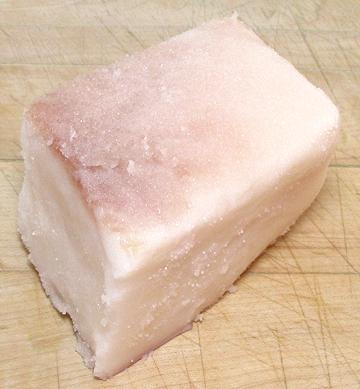 [Salo (Ukraine, Russia); Slonina (Poland); Slanina (Romanian); Slanina
(Chech, Slovak); Spekis (Latvia); Lasiniai (Lithuania)]
[Salo (Ukraine, Russia); Slonina (Poland); Slanina (Romanian); Slanina
(Chech, Slovak); Spekis (Latvia); Lasiniai (Lithuania)]
This is salt cured pork fat back. It may be brine cured or dry salt cured, as was the photo specimen. It usually has a layer of skin, and sometimes a thin layer of meat on the other side. East Slavic versions are sometimes cured with salt and paprika, while South Slavic versions are sometimes smoked. Salo may be slice thin and eaten raw on rye bread, or similarly, or it may be cooked, used in recipes much like Salt Pork.
Products like Salo and Salt Pork were formerly a very popular ingredient in American cuisine, but fell out of favor due to the American Heart Association's misguided vendetta against the natural fats we evolved with in favor of deadly trans fats. Back in the mid 19th century Americans practically lived on pig fat, and congestive heart disease was almost unknown then. This was actually pointed out by an elderly cardiologist at the kick-off for the AHA's "Heart Healthy Diet".
Now that much of the AHA's "modern medical knowledge" has been totallhy discredited, and even the role of saturated fats is being strongly re-examined, cooks can feel free to return to these flavorful traditional ingredients. Pig fat, by the way, has a better health profile than butter, even by the AHA's reconning - much less saturated fat than butter (44% vs 65%) and more of the healthy monounsaturated fats (45% vs 30%).
More on Cuts of Pork and
Pork Products.